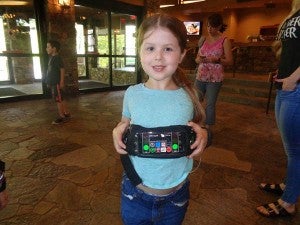6-year-old participates in medical trial
Published 10:15 am Saturday, May 28, 2016
CHARLOTTESVILLE
“I feel like a robot now,” six-year-old Chloe Jarratt said after the doctors finished attaching her to the various tubes and wires of the artificial pancreas.
Jarratt, along with her mother, Amanda, traveled to the University of Virginia Center of Diabetes Technology last Sunday to take part in a trial of a device, which would serve as an artificial pancreas for patients diagnosed with Type I diabetes. She was one of only 12 children in the entire nation to be part of the trial.

Chloe Jarratt displays the fanny pack that holds the technology which functions as an artificial pancreas.
The trial was run by UVa’s Launchpad program, and the development of the technology was funded by private donations, as well as grants from the Juvenile Diabetes Research Fund and the National Institute of Health.
Chloe was diagnosed on Nov. 6, 2014. The disease is caused when the body’s immune system attacks and destroys the insulin-producing cells located in the pancreas, which dismantles the body’s ability to control its blood sugar levels.
Chloe wears a Medtronic insulin pump and a blood glucose monitor and sensor, and also carries an iPhone with a Bluetooth device. As long as the Bluetooth remains within 20 feet of Chloe, if her blood sugar levels drop or spike to dangerous levels, her parents will receive a text message warning.
“That technology became available last Christmas and it’s been amazing. Chloe sleeps right across the hall from us, but it’s saved us a lot of worry at night,” Amanda said.
Being diabetic often disrupts the daily routine of a 6-year-old. Every time Chloe takes a shower the pump and the monitor must be disconnected, a process that is slightly painful. Playing at the playground must be interrupted every so often to make sure her blood sugar doesn’t drop. The spikes and drops in glucose can bring about mood swings and periods of lethargy.
“It changes you to go through something like that,” Amanda said. “Billy [my husband] and I have both said that Chloe has lost her innocence. She remembers life before. She remembers not having to do all this, so she resents it,” said Amanda.
“I don’t like having all the cords and stuff in me,” Chloe said.
Chloe’s endocrinologist — a doctor who treats patients with hormonal imbalances, such as diabetes — contacted Amanda and asked if would like to participate in a medical trial for a new technology to help diabetic patients.
The Jarratts received notice two weeks ago that Chloe had been accepted into the trial and last Wednesday they went to Charlottesville so she could undergo a physical to ensure that there were no medical reasons for Chloe to not take part in the trial. She received a new sensor and a FitBit motion sensor so that the researchers could monitor her glucose and physical activity for a few days. This process served as the “control” portion of the experiment so the researchers could compare the artificial pancreas’ effectiveness when compared to regular insulin pumps.
On Sunday when the trial began, they took out her insulin pump and attached her to the artificial pancreas, which consisted of three separate devices housed in a fanny pack.
“It was amazing,” Amanda said. “Just unbelievable. Normally she has huge spikes of blood sugar when she eats and big drops when she’s between meals, but while she was on that device, her glucose levels were like gentle, rolling hills.”
A normal glucose level is around 100, but due to the volatility of the disease, Chloe can experience spikes up to 375 or drops to 60 all within a single day. At night, when Chloe was attached to artificial pancreas, her blood sugar levels were steady, maintaining 99 all night long — a resounding success.
“They had the kids do all kinds of activities, because you know they’re children they’re very active and the researchers wanted to make sure the device could keep up,” Amanda explained.
And for the most part it did.
“The device has never been tested on children aged 5 through 8 before. They’ve done adults and they’ve done teenagers, but not kids this young,” Amanda said. “The researchers told us that because of the success of the trial, depending on funding, they may be able to do another in 2017. And we’re hoping that we may be able to participate again.”
Similar trials in Italy and France have resulted in what are known as longitudinal studies, in which the same subjects use different, updated versions of the artificial pancreas over time to ensure that the improvements being made to the technology as the product develops allow the pancreas to be more effective.
“All the families involved are hoping it gets funded and it works out that we can participate again,” Amanda said. “I absolutely would in a minute. There was definitely a sense of camaraderie between is because we all knew what it was like to have to care for these kids.”
“I felt like myself again,” Chloe added.
But, unfortunately, the trial had to come to an end. Amanda said the worst part as a parent was having to give the pancreas back.
“Chloe cried the whole way home,” Amanda said. “One mom said, ‘I don’t know what’s worse. Not knowing this technology exists and having no hope. Or knowing that exists, touching it, attaching it to your child, seeing it work so well, and then having to give it back.’”
One of the things the doctors stressed to the kids stuck in Amanda’s mind.
“I love that Dr. DeBoar, the main doctor, told the kids ‘You are going to be a big part of helping the kids like you,’” she said. “‘By letting us attach all this stuff to you, you’re going to help so many kids.’ And that to me made it worth the experience.”





